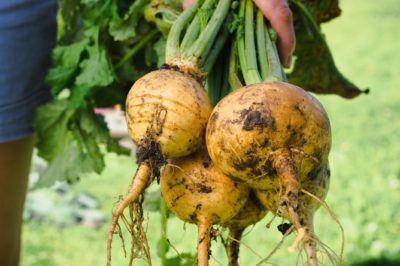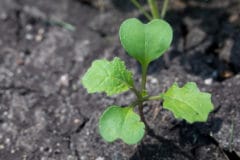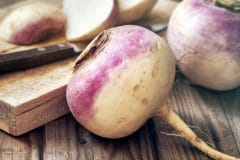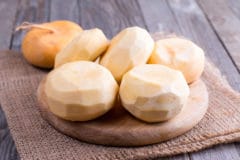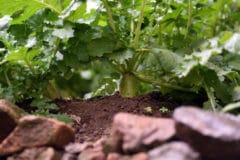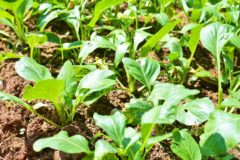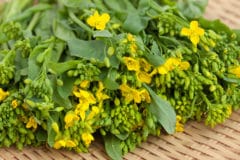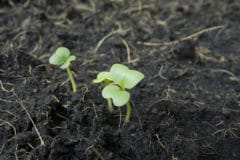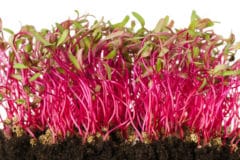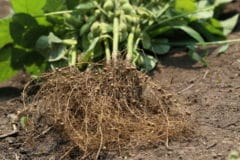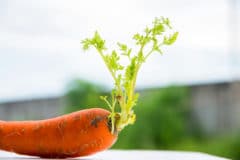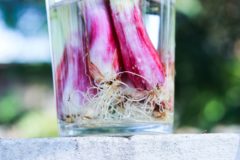When Should I Plant Turnips?
Whether you are growing your turnips to harvest the greens, the roots, or both, you can plant turnips either in the early spring or in late summer to early autumn and through the winter if your winters are mild enough that the ground never freezes over. Both the greens and the roots become tough and bitter if they are grown when the temperatures soar above 75°F (24°C), so avoid planting turnips that would mature during the hottest part of the summer.
What Date Should I Use for Spring Planting?
Since turnips are cold weather crops that are sown directly into the garden, you can plant your first crop two to three weeks prior to your last frost date in your area. Because turnips grow so quickly, maturing in approximately 60 days, you can then plant another crop every three weeks.
For turnip roots, your last planting should be two and a half to three months before you expect the heat to begin. For turnip greens, however, you can keep planting them up to a month and a half to two months before you expect the weather to turn hot.
What Date Should I Use for Fall Planting?
Wait to resume planting your turnips until the temperature drops back below 75°F (24°C), which could be as early as August in some areas. As in the spring, you can plant a new crop every two weeks.
If you live in an area where the ground freezes over in the winter, time your last planting by the first hard freeze date in your area. If you are harvesting your turnips for the roots, then stop planting 10 to 11 weeks before that hard freeze date, but if you are harvesting turnip greens, continue planting up to seven or eight weeks before that date.
What Is the Best Temperature Range for Growing Turnips?
Turnips produce the sweetest and most tender roots and greens when they are grown at temperatures between 50°F – 70°F (10°C – 21°C). The seeds require a soil temperature of at least 40°F (4°C) to germinate, and the turnip bulbs form best at around 60°F (16°C). However, a few frosts in the fall only sweetens the taste.
What Is the Best Place to Plant Turnips?
Turnips prefer a space with six to eight hours of full to partial sun a day and loamy or sandy soil. The soil should be well-drained and have a pH between 5.5 and 6.8. Turnips have been nicknamed a “mop up crop” because they will still find enough nutrients in the soil even if you plant them in the beds where you grew your sweet corn, squash, beans, and onions. They will even grow in poor soil.
Do I Need to Prepare the Soil for Turnips?
You will need to loosen the soil, break up clods of dirt, and remove any stones whether you are growing your turnips for the roots or the greens. If you are growing your turnips for the greens, a depth of 10 inches is sufficient, but if you are growing your turnips for the roots, you will need a depth of 12 to 15 inches.
In addition, before planting your turnips, work 2 to 4 inches of compost or an aged organic fertilizer into the soil.
How Do I Plant Turnips?
Turnips are planted directly into the soil in your garden. Broadcast the seeds by hand or use a planter at three to 20 seeds per foot. Your rows should be 12 inches apart. Cover the seeds with 1/2″ of soil using the back of a rake.
If the soil isn’t moist, water the seeds immediately after sowing them. To keep the soil moist to encourage the seeds to germinate, keep your turnip patch covered with burlap bags for three days.
When your turnips are about 4 inches tall, thin them to 4 to 6 inches apart if you are growing them for the roots. If you are growing them for the turnip greens, you can thin them to 2 to 3 inches apart, but you can also just let them grow.
Can I Grow Turnips in Containers?
You can grow turnips greens in containers. You can use any container that is deep enough to accommodate the roots and that supplies sufficient drainage, but the roots aren’t as large if you don’t thin the turnips.
Top soil is too heavy for container gardening, so use a potting soil for garden vegetables or herbs and garden vegetables.
How Do I Care for Turnips?
Cover your turnip patch with mulch to retain moisture and discourage weeds. Keep the area well weeded.
Consistent watering is important to prevent turnip roots from becoming stringy or woody. Turnips need one inch of water per week.
What Diseases Infect Turnips?
Both downy mildew and powdery mildew can attack turnips.
Downy mildew is a parasite that is related to algae. It requires water on the leaves of your turnips to infect them, so one way to prevent it is to water with a soaker hose. Another way is to make sure that air is able to circulate around the leaves. If the infection isn’t severe, it will die off with a drop in humidity.
Powdery mildew is a fungus that first appears as round, white spots on the leaves, as if the leaves are coated with flour. You can spray the leaves with neem oil, sulfur or lime-sulfur, potassium bicarbonate, or a mixture of 1 teaspoon of baking soda in 1 quart of water. Using a soaker hose and ensuring air circulation also helps prevent this form of mildew.
If a plant is badly infected with either type of mildew, pull it up and destroy it to prevent other plants from becoming infected. Don’t use infected plants in your compost.
What Pests Attack Turnips?
The pests that infest turnips are the same as those that infest the other members of the closely related Brassica family. They include:
- Flea beetles
- Aphids
- Root maggots
- Cabbage moth caterpillars
Aphids can be flicked off plants with a garden hose, and row covers prevent flea beetles and the parent flies and moths of the caterpillars from reaching your turnips to lay their eggs. Diatomaceous earth punctures soft-bodied aphids and caterpillars causing them to dehydrate and die. Sprays such as tomato leaf spray, garlic spray, and a spray made with water and dishwashing detergent also eliminate these pests.
Including companion plants in your garden helps to repel pests, lure pests away from your turnips, or draw insects that prey on pests to your garden. Rotating members of the Brassica family with other unrelated veggies also discourages repeated infestations by pests and diseases.
When Do I Harvest Turnips?
You can begin harvesting turnip greens about a month after planting, and the roots can be harvested after about two months. Harvesting greens from turnips that were planted in late summer into the fall after a few days of cool weather ensures the sweetest taste. Roots harvested just after a light frost will also taste sweeter.
After about 45 days, you can check the roots by pulling up one plant. Young, smaller bulbs that are 2 to 3 inches in diameter are the most tender. The larger the bulb, the greater the chance it will have become woody.
How Do I Harvest Turnips?
When harvesting greens, carefully snip off no more than a third of the outer leaves from each plant, being careful not to damage the bulb.
When harvesting the roots, simply loosen the soil around the plant and pull smaller bulbs up out of the ground. Use a shovel or garden fork to harvest larger bulbs. Place the blade of the shovel or the tines of the fork at an angle near the plant and push it into the soil so that it goes down below where the root should be. Then, push down on the handle to lift the bulb up out of the soil.
If the turnips you plant in the spring bolt, or produce flowers in preparation for producing seeds, you can harvest the unopened flower buds and seed pods to add to salads, or you can harvest the seeds when they ripen.
How Do I Store Turnip Greens?
Because turnip leaves are covered with tiny hairs, soil sticks to them. You will need wash the leaves thoroughly with several water changes. Then, you can place them in a plastic bag and store them in your refrigerator for about a week.
How Do I Store Turnip Roots?
If you live in an area where the ground doesn’t freeze over during the winter, you can store your turnip roots in the ground all winter long and harvest them as you need them. If the ground does freeze over, you still can store your turnips in the ground up until just before the ground does freeze. Just cover the area above your turnip patch and 18 inches beyond it with 2 feet of leaves, straw, or hay. You also can store turnip roots in a crate in your root cellar, garage, or basement; in your refrigerator; or in your freezer.
To prepare your turnip roots for storage, cut off the tap root and the greens leaving about an inch of the leaf stems immediately after you remove your turnip roots from the ground. Sort the larger roots and remove the ones with cuts or blemishes to use immediately.
Storing Turnip Roots in Your Refrigerator
You can keep the smaller roots and a few larger roots in your refrigerator for two to three weeks, but either prepare the remainder for freezing or for storage in a wooden crate.
Storing Your Turnip Roots in Your Root Cellar, Garage, or Basement
After you harvest your turnip roots, you can store them in a crate in a root cellar or in a cool, dark space in your basement or garage for three to four months.
To store your turnips in a crate, place a layer of damp sawdust or newspaper in a crate. Lay your turnip roots in a single layer on top of the newspaper or sawdust leaving room for air to circulate between them. Then, add another layer of damp newspaper or sawdust.
Store your crates of turnips in a root cellar or in your garage or basement. Check your turnips regularly for roots that might be sprouting or spoiling. If you have turnips that are sprouting, you can plant them in a pot with potting soil mixed for vegetables or herbs and vegetables and harvest the greens.
Storing Your Turnip Roots in Your Freezer
To freeze turnip roots, wash and peel them and then dice them into 1/2 inch cubes. Blanch them in boiling water for two minutes and then dowse them in ice water for three minutes. Place the turnip cubes on a cookie sheet, cover them with freezer wrap, and place them in your freezer for two hours before transferring them to freezer bags or containers.
To prevent freezer burn, remove as much of the air as possible from the freezer bags. You can store frozen turnips in your refrigerator’s freezer compartment for nine months or in your deep freezer for a year.
After cubing your turnips, you also can roast them and then freeze them without blanching, or you can blanch them, mash them, and then freeze them.
